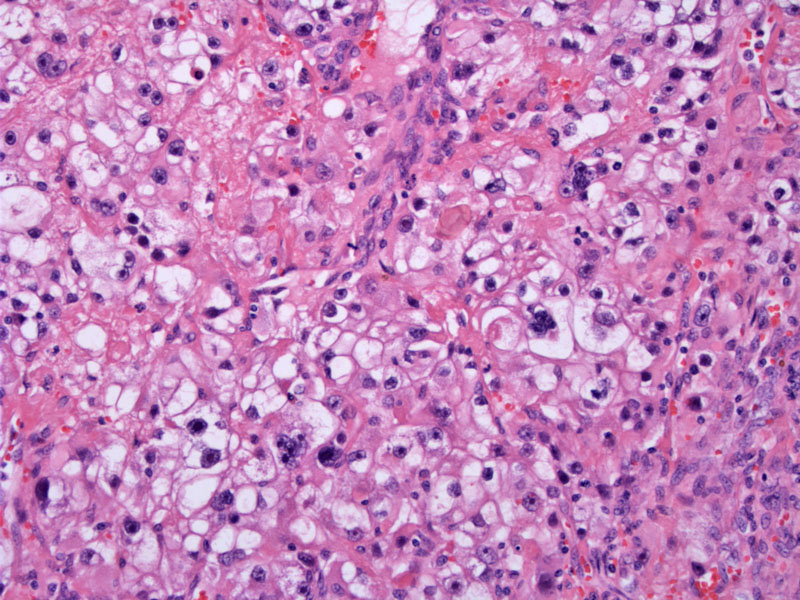System: Genitourinary: Kidney: Neoplastic: Sarcomatoid Renal Cell Carcinoma

System: Genitourinary: Kidney: Neoplastic: Sarcomatoid Renal Cell Carcinoma



Case 1: Residual chromophobe renal cell carcinoma is identified. These areas show polygonal cells with well-defined borders and clear or eosinophilic cytoplasm with perinuclear clearing, but there is more pleomorphism than usual.
The chromophobe renal carcinoma transforms into a poorly differentiated component to the right. To establish a diagnosis of sarcomatoid renal cell carcinoma, an epithelial component must be identified morphologically (as shown here), ultrastructurally, or immunohistochemically.
Irregular spindle cells with pleomorphism is admixed with the more carcinomatous focus (bottom left)
The sarcomatoid component shows hyperchromatic blunt spindle cells, and numerous mitoses.
Case 2: A kidney biopsy shows a spindled proliferation obscuring the normal kidney architecture.
On higher power, tumor giant cells can be appreciated.
The keratin stain AE1-AE3 nicely highlights the epithelial component of the tumor.
Vimentin highlights the sarcomatous component.
Sarcomatoid renal cell carcinoma represent a high-grade dedifferentiation of an epithelial neoplasm of the kidney. In general, the incidence of occurence in RCC is around 5% (Cheville). This type can occur in all subtypes of renal cell carcinomas, including clear cell, papillary, chromophobe, and collecting duct carcinoma. Rare cases also show heterologous elements.
Also known as spindle-cell carcinoma, anaplastic carcinoma or carcinosarcoma, these tumors are composed of spindled and pleomorphic giant cells that mimic malignant fibrous histiocytoma or fibrosarcoma. Occasionally, the sarcomatous component may demonstrate differentiation into bone or cartilage. Osteoclast-like giant cells could be present (Rosai 1259).
An examination of the immunoprofile of 18 cases of sarcomatoid RCC revealed their epithelial and sarcomatous nature. 17 (94%) were immunoreactive with AE1/AE3, and this appears to be the best epithelial marker. EMA and CAM 5.2 stained 9 (50%) and 7 (39%) cases respectively. In terms of sarcoma markers, 10 cases (56%) stained for vimentin, whereas as SMA (33%), LeuM1 (22% were less effective (Delong).
Often presents with advanced stage. The mean age of sarcomatoid carcinoma is slightly higher than that for ordinary renal cell carcinomas.
Resection. Not very sensitive to chemotherapeutic agents.
Poor, with frequent distant metastases and short overall survival.
Cheville, J. C. , C. M. Lohse , and H. Zincke . et al. Sarcomatoid renal cell carcinoma: an examination of underlying histologic subtype and an analysis of associations with patient outcome. Am J Surg Pathol 2004. 28:435–441.
DeLong W, et al. Sarcomatoid renal cell carcinoma. An immunohistochemical study of 18 cases. Arch Pathol Lab Med. 1993 Jun;117(6):636-40.